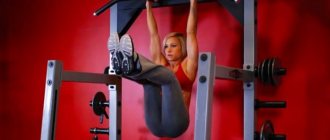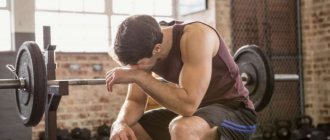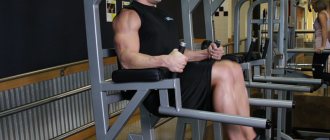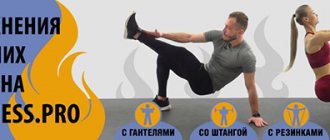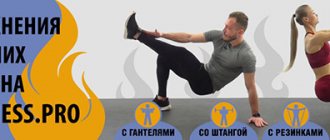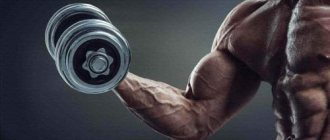Method of using force on the horizontal bar
Methodologist NVMU (Sevastopol PKU) Korolev S.A.
The horizontal bar is a very good piece of equipment that can be an excellent base before starting to visit the gym (maybe you want to do workout). This is also an excellent addition to Nakhimov’s regular training sessions with free weights and exercise machines.
But, unfortunately, not everyone exercises on the horizontal bar, and the reason for this is poor physical fitness. But we must not forget that strength is something acquired, which can be acquired quite quickly if you train regularly. If you have good physical fitness, you will be able to perform various exercises on the horizontal bar, for example, for starters, a one-arm exercise on the horizontal bar (popularly called a “flag”) and a two-arm exercise (for the pros).
Medium overhand grip
This is a classic option. This type of pull-up is performed both in physical education classes and by American special forces. The main emphasis is on the biceps and back muscles.
To perform this stretch, you must do the following:
- grab the horizontal bar with your hands spaced shoulder-width apart;
- hang and bend your back a little;
- cross your legs so that your body does not become loose;
- pull yourself up, bringing your shoulder blades together.
When the body is at the extreme point, you need to touch the crossbar with your upper chest. Muscles are best stretched when the arms are fully extended. Otherwise, it will not be possible to achieve full stretching.
What muscles work
So, let's find out what is involved here and what this exercise pumps up, and very effectively:
- pectoralis major;
- latissimus dorsi;
- triceps;
- biceps;
- shoulder;
- anterior bundle of the deltoid muscle.
In addition, the rectus abdominis and quadriceps femoris muscles are involved. Thus, when performing pulling and pushing movements at the same time, as happens when pushing out, almost all muscle groups of the upper body are trained.
Article on the topic: “Angel coming out on the horizontal bar”
Medium underhand grip
It is a simpler and easier to perform variation compared to the top one. This is due to the fact that the main part of the load is received by the biceps. Unlike the back, they are initially better suited to pull up. This type of exercise is ideal for beginners who have difficulty with an overhead grip.
The distance between the hands should be the same as when performing pull-ups with a wide overhand grip. The difference is that the palms do not turn away from themselves, but, on the contrary, towards themselves. Performing this exercise is no different in principle from the previous one, but when the shoulders begin to move up, they are pulled back and then down. During the entire pull-up, your forearms should remain perpendicular to the floor surface at all times.
Injury hazard
Tricks on the horizontal bar for beginners and even experienced athletes have a very high risk of various injuries. According to a study by some sports publications, stunt elements on the crossbar are among the top 5 most dangerous types of physical exercise. Indeed, great demands on the development of individual muscles and complex performance techniques lead to the fact that an athlete can get injured at any time. The combination of static and dynamic movements involves a large number of muscle groups, stabilizer muscles and synergistic muscles.
It is when performing stunt elements that many beginners receive serious injuries: sprained ligaments, muscles and tendons; ruptures of muscle fibers and separation of muscle from bone; dislocations and prolapse of the joints of the elbows, knees and pelvis; severe compression fractures of the limbs; concussions and internal organ injuries.
Undoubtedly, most injuries can be avoided by strictly following the training program and taking insurance measures (classes in gyms with good equipment, safety equipment and help from partners). However, you must always remember that it is very difficult to completely eliminate the risk of injury.
Wide grip to chest
Pull-ups on the horizontal bar have a wide variety of effects on the muscles. This variety is considered the most useful. This powerful and beneficial exercise certainly requires a certain level of fitness and effort. This kind of pull-up scares beginners because it is not just difficult to do, but very difficult. Among those who regularly visit the gym, it is rare to meet people who know how to do it correctly. The exercise allows you to pump several spinal muscle groups at once - the latissimus, teres, and trapezius.
To do this pull-up, the bar of the horizontal bar is grasped from above. The grip should be such that your hands are at the same distance as when doing a bench press. An important nuance is that the thumb is not on the bottom, but on the top. This also applies to the other fingers. In other words, the crossbar is held on top. Thanks to this position, the back muscles are stretched as well and efficiently as possible. When pulling up, the biceps muscles should be relaxed.
The upward movement is carried out by bringing the shoulder blades together. It is necessary to stretch upward until the chest touches the bar. Achieving this position should be preceded by bending in the back and looking up. When they reach the extreme point, they linger in this position for several seconds.
Wide head grip
Another common and quite popular variation of this exercise. The main nuance that you should remember when performing this version of pull-ups is that it is quite traumatic. Risk arises from incorrect execution. If the shoulder joints remain immobile, a very serious injury can occur. The load falls on the same muscle groups as when pulling with a wide grip to the chest, but the latissimus dorsi muscles are worked the most.
The width of the grip is similar to that of the bench press. When doing this exercise, you should under no circumstances bend your back. The body and legs should form an even, single line. The elbows must be kept pointing downwards at all times. They shouldn't look back. At the highest point, the neck should not come into contact with the surface of the crossbar.
Until the full range of movement is achieved, you need to spend a certain amount of time training. This allows you to master the correct technique. If you try to do a pull-up right away, you may get injured. A signal to stop further movement is pain in the back or shoulder joints. You can't stop moving suddenly. It is necessary to slowly lower to the starting position. This will avoid injury or minimize damage.
First performances of the element
If the pull-up is completely mastered the required number of times (12-15), you can begin training the exit. At first they may not work out very well, but not for everyone and not always. To perform an exit, you will need to sway slightly and, as you move forward, sharply throw your elbows up. If necessary, you will need to do push-ups. It is better if push-ups are not required, but it all depends on dexterity and skill.
After exiting, you need to immediately descend along the same trajectory. In this case, the body is slightly moved forward to obtain a slight acceleration. This makes it possible to take a position on the crossbar in the front support. At first, awkward rocking should not be frustrating. Over time, the body will be carried out completely naturally.
It is worth emphasizing once again that there should be no rush to execute the exit. First, you need to confidently perform pull-ups at least to the bottom of your chest. If you master them sufficiently purely in the required quantity, then you can begin to try to make a way out. Otherwise, you can simply harm yourself, and then you will have to practice the exercise much longer. A well-thought-out training program will bring success in this endeavor; in this case, the training will not take too long.
Narrow overhand grip
Unlike previous variations, the grip is done with narrowly spaced hands. This exercise is great for those people whose wrist joints have limited mobility. When the bar is grabbed from below, pull-ups allow you to work out the serratus, lower latissimus muscles well. The shoulder muscles are also involved to some extent.
The palms on the bar should be as close to each other as possible. The thumbs are practically touching each other. Pull-ups are performed with a bend in the back. You should try to touch the lower part of your chest with the bar.
One-arm force release technique
The technique of execution is almost the same as on both hands. The exercise is performed with alternate hands in the “flag”.
- To do this, grab the middle of the bar and do a pull-up.
- Then smoothly transfer your body weight to one hand and raise the other point-blank over the horizontal bar, so you get something similar to a “flag” figure.
- Next, you need to transfer the weight to your hand in support above the crossbar and bring your other hand to the “flag”.
- The most difficult element of this variation will be the press up. To perform it, you need to be good at doing push-ups on parallel bars or a bar.
Narrow underhand grip
This type of pull-up is easier than the previous one. It is performed either when it is difficult to do an exercise with an upper narrow grip, or to stretch the latissimus dorsi muscles. Along with this muscle group, the biceps are also worked out.
Similar to the previous option, this exercise also involves placing your hands as close to each other as possible. The difference is that the palms are facing towards you. When they weigh on straight arms, they bend in the back and look at the hands. You need to focus on bringing your shoulder blades together and moving your shoulders back. Pulling up to the extreme point, they try to bend more strongly in the back and touch the horizontal bar with the lower part of the chest.
Other types of training
Bars are a good way to prepare your body for various strength elements. In addition to regular push-ups, you can also perform various additional elements. But even the simplest exercises will provide excellent basic training.
A simulator such as a horizontal bar should become your reliable friend if you want to stay in good shape. With the help of such training, you will have a trained and flexible body that girls like so much. Moreover, you will not need to spend a lot of money on visiting the gym.
Subscribe to the blog, read news about the world of sports. If you liked the article, then do not forget to share it with your friends on social networks. What exercises can you do on the horizontal bar? Share your successes in the comments.
Stay strong!
Neutral grip along the bar
It is a rather specific type of pull-up on a horizontal bar. This pull-up is aimed at working the latissimus inferior serratus muscles and to some extent the shoulder muscles. The bar is grasped so that one palm is in front of the other. While doing pull-ups, bend your back and try to touch the bar with your chest (lower part). The head is turned away from the projectile, changing sides with each pull-up. Hands change with a new approach. To make the exercise more comfortable, a V-shaped handle is often hung on the horizontal bar.
Lifting with inversion
Having learned to do pull-ups, a person begins to think about the need to learn new, more complex exercises. The very first element is usually just such a rise. It's all about its fairly simple learning.
To perform it, you first need to learn how to pull yourself up. Also, before starting to practice the lift, you need to work with the press. A good lead-up exercise is to raise your legs to the bar. In essence, in this way the first phase of the element is worked out; in fact, the abdominal pull-up bar is very useful.
Technique
We grab the bar with an overhand grip, preferably wide or medium. We pull the body up. After this, we throw our legs forward over the bar and turn our body around the horizontal bar. To finish, you need to raise your body point-blank in front. All elements are completed.
Partial pull-ups with underhand grip
These pull-ups are aimed at working the biceps. They allow you to concentrate the load. The horizontal bar bar is grasped with a reverse medium grip, when a right angle is formed between the forearm and shoulder. Having taken the starting position, they pull themselves up exactly to the middle. The body should be fixed vertically, and then begin to move upward, trying to touch the crossbar with the collarbones. Lack of stretching and low amplitude allow you to get maximum load.
TYPES OF PULL-UPS ON THE PULL-UP BAR from LvL 1 to LvL 80 and what muscles work in each
https://youtu.be/sk-OVxan-ag
Advanced level
https://youtu.be/AmvHts4ZXOo
Horizontal hang (forward/reverse/mixed grip)
Movement: from the starting position, using the strength of the abdominal muscles, back, arms and shoulders, move the body and straight legs to parallel with the surface, without changing the position of the hands on the horizontal bar.
Rise by revolution.
Movement: With a dynamic movement, lift your body over the bar and at the top point of the amplitude, squeeze your body over the bar.
Tricks on the horizontal bar video: “Climbing with a coup”
Holding your body over the bar with your arms straight.
Movement: Perform an inversion lift until your body is vertical over the bar. Squeeze your body perpendicularly upward, maintaining a straight line with your arms, body, pelvis and legs.
"Officer exit by force"
Movement: This is a stepwise movement consisting of three phases.
Phase 1: Perform Checkbox.
Phase 2: From this position, rotate in the opposite direction and extend your arm behind your back.
Phase 3: Press your body upward.
Tricks on the horizontal bar video: “Officer exit by force”
"Captain's Rise" ("Captain's Exit by Force")
Movement: This is a stepwise movement consisting of two phases.
Phase 1: from the starting position of hanging on the bar, bring your legs between your hands and, with the simultaneous effort of your arms, abs and back, throw your legs onto the bar.
Phase 2: Using momentum, rotate your body over the bar until it is vertical with the surface.
Tricks on the horizontal bar video: “Captain’s lift”
"Exit of the Angel" ("Crucified Angel")
Movement: From the starting hanging position, perform a pull-up. At the final point of the amplitude, alternately throw each arm onto the bar and try to straighten them completely. Keep your body above the bar using the combined strength of your arm, abdominal and back muscles. The angle between the arms and body is 90°.
"Tread of an Angel" ("Ascension of an Angel")
Movement: from a hanging position, pull your legs up in an arc, imitating steps on the surface. The amplitude is circular, the movement is considered completed if at least 4 “steps” are taken.
Training program on the horizontal bar
Doing pull-ups, like any other exercise, requires practice. You should start with them only after you have determined your maximum. Next, having decided on a group, they begin to train at least twice a week, and after a month they repeat the test. If the indicators have increased, move on to the next level of difficulty.
Category one – one or two pull-ups
People who manage to do no more than two pull-ups in one approach have the weakest level. They should begin working with passive pull-ups where body weight loading is kept to a minimum. This involves using a bench, that is, lifting with the use of your legs. The lowering is carried out under the force of its own weight. For the first 14 days, you should train in 3 sets, in each of which up to 5 repetitions are done, when the lowering takes at least 5-6 seconds. Then it is increased to 8 or 10 seconds, but no more than two approaches are done.
Category two—from two to four attempts
Those who manage to perform two or more successful pull-ups should do more approaches, but with fewer repetitions. The first repetitions must be performed intensely in order to load as many muscle fibers as possible, maximizing the neuromuscular connection. The first two weeks of training, do eight approaches, each of which should contain exactly half the repetitions of the best indicator when first testing your ability. Between individual rest cycles for 1-1.5 minutes. The further training schedule already involves performing in each set the full number of pull-ups that were done on the first attempt.
Category three - from 5 to 7 pull-ups
People who are able to do 5 or even 7 pull-ups are strong, but not yet very resilient. They can perform the exercise without any set counting. The rest between individual approaches can be anything. The main task is to do at least three or four sets.
Category four - from 8 to 12 times
Those who are able to do at least eight pull-ups in one approach are already too resilient and strong to work with their own weight. To improve your results, you need to use weights that should be no more than 10% of your own weight. The additional load will reduce the number of repetitions by three or four times, but will allow you to get maximum effect.

